by Fionn Adamian // June 21, 2024
For some time now, Berlin’s reputation as an artistic capital has been undergoing a healthy deflation. Even as the official credo of “poor but sexy” rumbled onward—if not in minds, then in spirits, if not in spirits, then in the doxa of tourist boards—most were already attuned to that fatal index of reality, the real estate market. For the British avant-pop duo Hype Williams, Berlin was nothing more than “the biggest coffee shop in the world”—and to think they said that a decade ago! Nostalgia, the city’s sacred cash cow, is more than a little at odds with present conditions of art production: an independent art space is more likely to be located in the unfinished studio of a suburban office complex (When You’re Calmer), the vacated kiosk of a swimming pool (TROPEZ) or the bedroom of the project’s curator (Mehringplatz 20), than it is to be based in one of the city’s historic “run-down” districts.
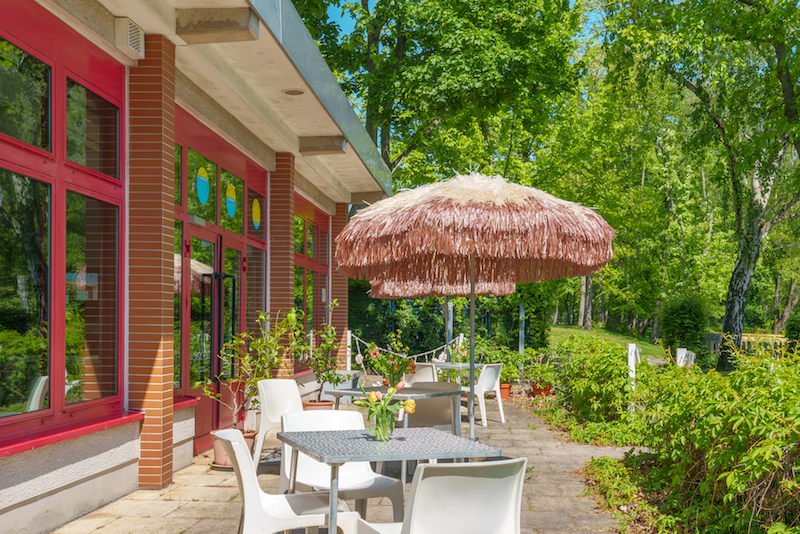
TROPEZ // Courtesy of Project Space Festival, photo by Ink Agop
And that’s perfectly fine. The beauty of the exhibition sites that comprise the 2024 Project Space Festival is the ethos of improvisation and scavengery. Of all the spaces—in the most literal sense of the word—that I visited in the first half of the festival, I was most taken with the garden house of the SAP Space in Rixdorf, Neukölln, an extension of Ilyn Wong and Johannes Knall’s ground floor apartment. The SAP garden has an unpretentious, neighborly feel, with lots of sun and light and air. In the context of the exhibition, Sidsel Ladegaard’s work makes the most deliberate intervention in the garden space, with a bead-strung aluminum ladder propped against the shed, an unobtrusive storage trunk serving as the base of bite-sized ceramic fragments and several rain gauges supported by surreal porcelain fingers that emerge from the soil.
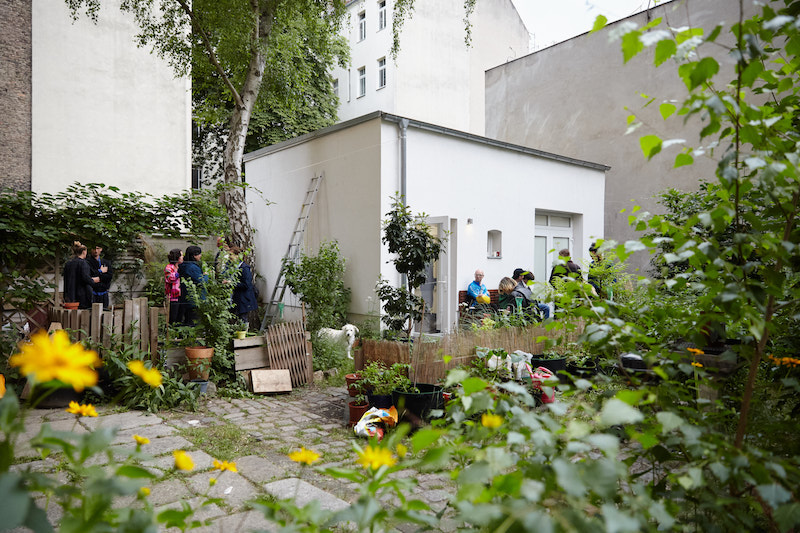
SAP Space, ‘A Question of Intervals and Scales,’ outside view, works by Alizée Armet, Nadja Verena Marcin, Janne Höltermann, Sidsel Ladegaard, Project Space Festival 2024 – Day 03 // Photo by Joe Clark
The garden house itself is divided by a partition, and the first half of the exhibition brings four pieces together in an impressively economical use of the room. There is Alizée Armet’s intriguing artwork on the arbuscular mycorrhizal fungi, which contrasts a petri dish of the specimen with a single-channel video loop displaying a dense close-up of the fungi’s environment. Nadja Verena Marcin has a cleverly staged photograph of her naked body on the forest floor, a nature morte that looks halfway between the classical figuration of Eve and the classical figuration of a crime scene.
But the room’s centerpiece is Marcin’s ‘Sissi,’ a work that refuses to leave you alone. Hanging from an iron chain in the middle of the room, the wooden box lures the visitor to an eyehole with high-pitched bird sounds. Peep-peep! Peep-peep! From the eyehole you glimpse a video of the artist in a canary colored tank top, emitting these manic inflections as she wobbles on a beam.
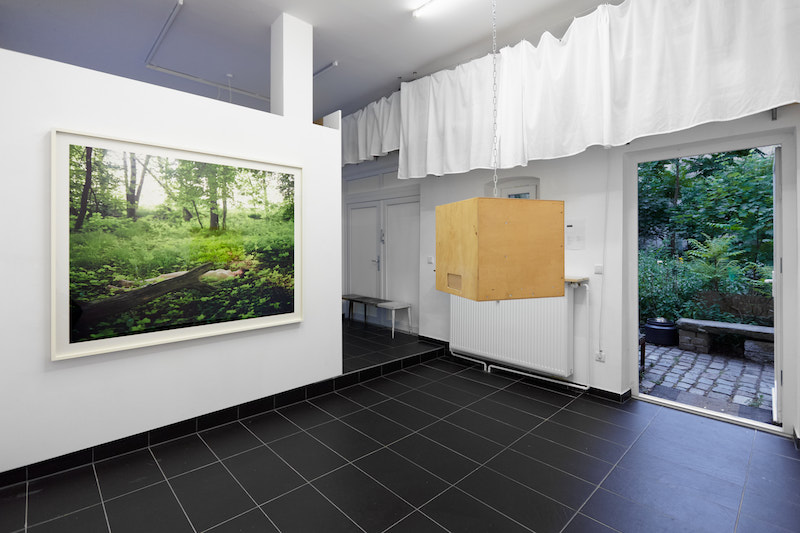
SAP Space, ‘A Question of Intervals and Scales,’ works Nadja Verena Marcin, Project Space Festival 2024 – Day 03 // Photo by Joe Clark
The exhibition at SAP is entitled ‘A Question of Intervals and Scales.’ This thematic interest appears in its most pronounced form in Janne Höltermann’s cerebral and transfixing video work, ‘TEU,’ which is screened on the other side of the garden house’s partition. In ‘TEU,’ a static camera records the crawling passage of container ships along a sunny, mansion-studded waterfront. Occasionally, as the camera zooms in and out from the boat’s cliff side, the presence of a miniscule crew member catching fresh air on a platform signals the massive scale of these industrial behemoths. Instead of revealing a broader panorama, the outward zoom of the camera captures an expanded perspective on the monochromatic containers, which become small enough to look like the rectangles of a Piet Mondrian, then like a massive game of tetris, then like the black and white static of a television screen. The represented reality collapses into the real space of the medium, the video repeats itself and the whole process goes off without a hitch. You can absorb the formalism of this slow cinema like the vitamins of a vegetable.
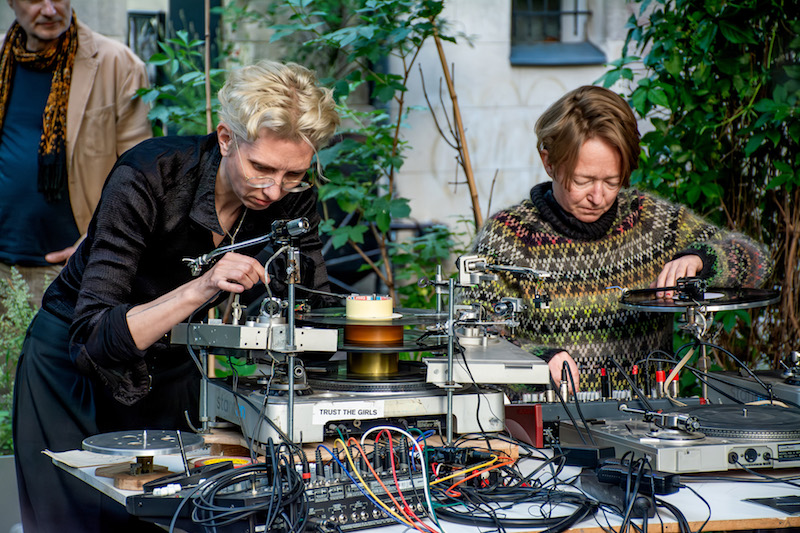
Vinyl-terror & -horror: ‘[lively music],’ special event in conjunction with the Project Space Festival 2024 // Photo by Alexander Schmidt
On the Tuesday after the festival launch, I attended a performance by Vinyl-terror & -horror—a Danish duo consisting of Camilla Sørensen and Greta Christensen—at die raum in Prenzlauer Berg. Some of the turntables were cracked in half like a patient on the operating table; others had their bases removed so that the vinyl appeared like a free-floating saucer; others had the spindle altered so that multiple records could be stacked on top of one another and played simultaneously. There is more than a touch of humor in the way that the duo preside over this retro-futuristic invention, which no one else, in all likelihood, knows how to operate (at die raum, Sørensen was dressed in the slender black outfit of an orchestral conductor, Christensen had a bandana tied around her neck like a mechanic). Surely not all of the wires rigged to the 12-channel mixer were necessary for the audio of the performance. Instead of packing up after their sound collage, the pair left this equipment that had looked so surreal, so animated just a moment before, dead and standing in place like a steampunk scrap heap.
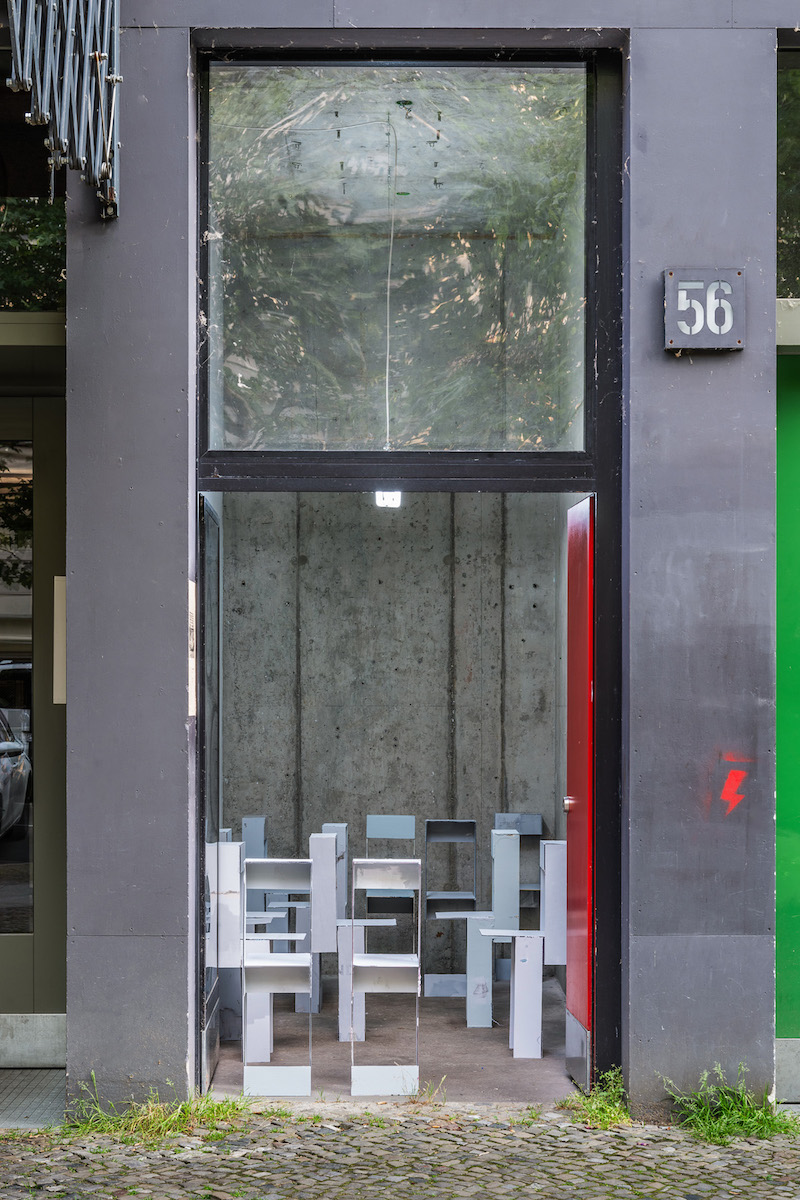
Anne-Mette Schultz: ‘Real Chairs,’ 2024, installation view // Photo by Jan Windszus
The Vinyl-terror & -horror performance took place in front of Anne-Mette Schultz’s installation ‘Real Chairs’ in die raum. The installation is made up of gray rectilinear cardboard chairs that fill the five-square-meter space, sealed by the street-side window front and the high concrete walls of the interior. The seats are simultaneously upright and flimsy, as though the slightest impression of weight would destroy the model semblance of the chair. None of the seats directly face each other in this asocial arrangement: even if we were to project a human presence onto the chairs of the vacant waiting room, we find that it is arranged to preclude the possibility of eye contact.
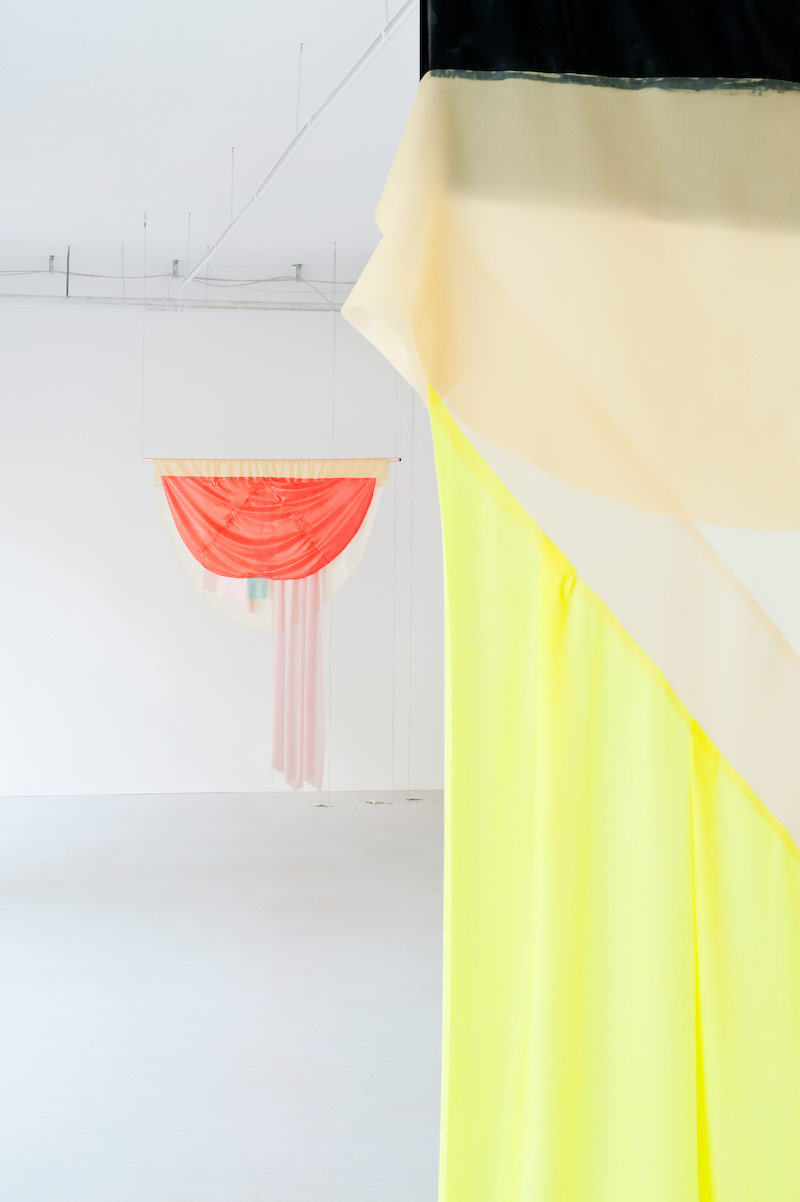
Melanie Jame Wolf: ‘Outlaw Feelings,’ 2024, installation view at Neun Kelche Berlin // Copyright Dorothea Dittrich VG Bildkunst 2024
For those interested in pulpier subject matter, there is Melanie Jame Wolf’s ‘Outlaw Feelings’ at Neun Kelche in Weißensee, an exhibition composed primarily of three latex artworks that stick to the eye as they do to the skin. On one end of the room, ‘the burden of grief (invisibility cloak)’ forms a sallow semi-circle with smaller pieces of fabric layered on top, including an orange egg yolk shape, a blue rectangle and a light rose skirt that falls beneath the bulk of the sculpture. On the other end of the room, ‘the burden of grace (a stage she’s going thru)’ involves two neighboring curtains, also of latex, that plunge downward from the solid black rectangles that form the sculpture’s cornice. One of these curtains seems to liquify on the floor; the other gives way with a diagonal cut to a neon-lime extension that also meets the ground in the shape of a puddle.
Between these two sculptures is the emotional core of the exhibition: an ominous pair of elbow-length medical gloves in rigor mortis, draped over the copper beam like a napkin over a waiter’s arm, violently phobic of a chance contamination. They inspire the thought of contact, the unwanted and impersonal kind, not just of doctors, of nurses, of surgeons, of anesthesiologists, but of people who are just a little bit repulsed by rage and grief. For a second you forget the fact of the exhibition space and you think to yourself: such a simple object, but such a strong parable. You could find them anywhere. They’re just a pair of latex gloves.
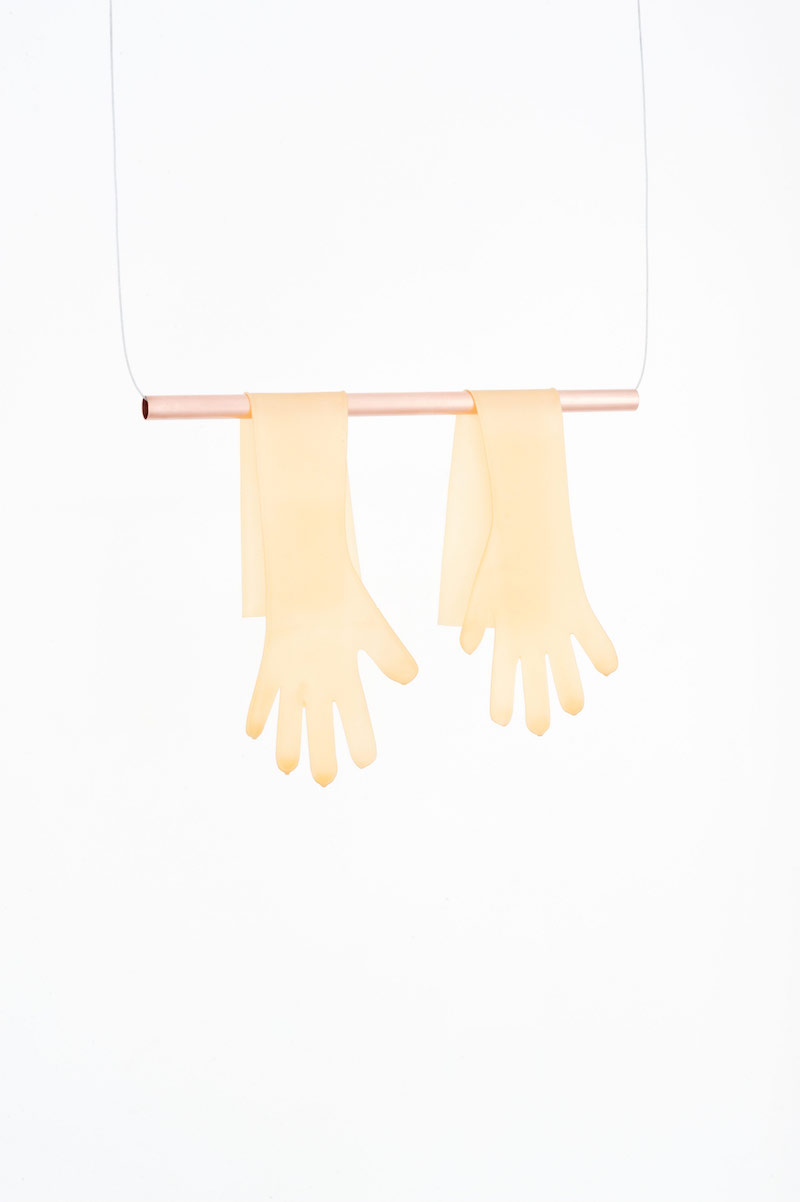
Melanie Jame Wolf: ‘the liquid beast (an actor acting),’ 2024, latex, copper pipe, exhibition view ‘Outlaw Feelings’ at Neun Kelche Berlin // Copyright Dorothea Dittrich VG Bildkunst 2024
At the vernissage of the exhibition, Wolf performed a campy operetta alongside the writer Maxi Wallenhorst and the sound artist MINQ, that reminded me a lot of the musical arrangements in the Roadhouse in Twin Peaks. At the beginning, MINQ stood at the front of the room like the host of a murder mystery party, and the performance gradually settled into a mixture of finely tuned choral refrains—“the burden of grief,” “the burden of grace”—and schlocky stand-up comedy. Then all of a sudden, I can’t remember who, one of the performers walked up to the mic and said something to the following effect: “Three unwanted conversations walk into a bar: the weather [Pause], a cancer diagnosis [Pause], and genocide [Emphasis falls on this last word]”.
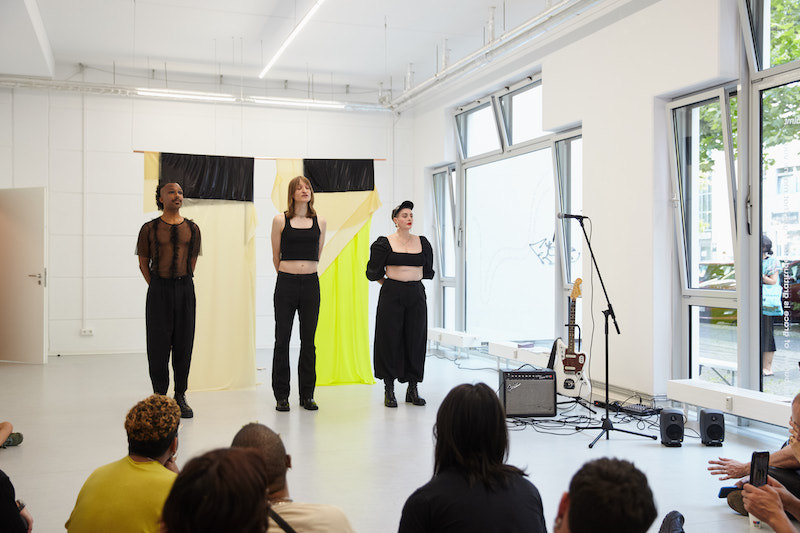
Melanie Jame Wolf: ‘Burden Ballads’ with performers Maxi Wallenhorst and MINQ, performance as part of exhibition ‘Outlaw Feelings’ at Neun Kelche, Project Space Festival 2024 – Day 8 // Photo by Joe Clark
I don’t want to presume the reaction of the other audience members to this bit, but for me there was something very important, and very telling, about the way this provocation was structured, with the violence it wanted to express so obscenely surpassing the formal limitations of its structure as a stand-up joke. It made me think of the January proposal for the Berlin Senate Department for Culture that would require artists receiving public funding to sign a commitment against anti-semitism that may include criticism of Israel within its purview. But no one on the side of the government seems prepared, as far as I am aware, to offer a credible differentiation of “acceptable” from “unacceptable” critique of Israeli state policy—one that in any case seems always to lie outside of the artists’ hands. The result is a weird sense of paranoia of speech, of double-crossing oneself with multiplied qualifications, the kind of neurotic tic that completely throws into question the “independence” of the independent art scene if your primary arts patron is the German state or the city of Berlin. This has implications for artist activism, to be sure, but it’s also about art in a more narrow sense: the dark humor of Wolf’s performance, which might in the future be made into an actual “outlaw feeling,” foreshadows the refusal of many to work as coterie artists for the city of Berlin.
Festival Info
Project Space Festival
Festival: June 1–30, 2024
projectspacefestival.berlin
Various Venues





















